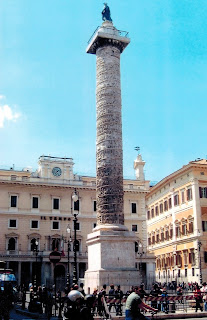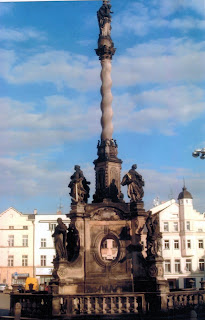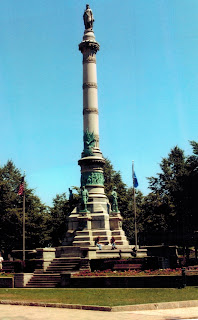 |
| Trajan's Column, Rome, c. 113, commemorating the military campaign against Dacia (now Romania) |
 |
| The Marcus Aurelius column, Rome, in Piazza Colonna, c. 193. |
 |
| Pompey's Pillar, Alexandria, 302. |
Other examples from the Roman world, that confirm the importance of this sort of monument, also survived the centuries: Constantine's column in Istanbul (330), and "Pompey's Pillar: in Alexandria (302) [right] were always well known.
 |
| The Venetian columns, 1100s. |
Simple, clear, and of urban importance, such monuments (after a Medieval hiatus when they were considered icons of paganism) reappear in the early middle ages, now sanctified by images of saints--not pagan emperors--at their summits. Those in Venice [left], one bearing the lion symbol of St. Mark (1126), and the other an image of St. Theodore (1172), are among the most famous.
Elaborate columns supporting images of the Holy Trinity (17th-18th centuries) or the Virgin Mary (17th-19th centuries)--usually offering thanks for their intercession in stopping plagues--were ubiquitous in Europe; a splendid one in Olomouc (Czech Republic) [below], with a column in High Baroque style, was completed in 1723.
 |
| In the Baroque style, Czech Republic, 1723. |
 |
| Warsaw, 1644. The first column to have a person on top. |
 |
| George Washington on top of this large column in Baltimore, MD, 1829. |
 |
| Phoenixville, PA, (c. 1890) with spiral bands perhaps derived from Trajan's column |
In the post-Civil War era the columns often displayed a figure of "Liberty," "Columbia," an American eagle, or most often, a statue of the "common soldier." Such soldier figures provided the viewer, often grieving for a lost husband, brother, or son, greater empathy. Such monuments can be found all across America, both North and South, for the half-century following the war.
Several representative ones can be illustrated. The elegant version from Ogdensburg, NY (1905) follows the model of the "basis type" closely. An elaborate version of this model, beautifully carved in white marble, is in Phoenixville, PA: it even emulates the spiral band motif of the Column of Trajan! [Right]
 |
| A post-Civil War column, Buffalo, Lafayette Square, 1878. |
Somewhat more elaborate versions included statues of soldiers
representing the branches of the military, as seen in Boston (1877) and Buffalo (1878) [left] around the base.
 |
| Separate pedestals, Lancaster, PA, 1874. |
Some examples, such as that in Lancaster, PA (1874) [left], place these figures on separate pedestals, for ease of viewing. This monument uses a pillar--a "square column"--as its support.
But having an actual historic person on the summit was very rare: that in New Orleans (1884), capped by Robert E. Lee, is an example [below]. (The bronze figure has recently been removed.)
 |
| Commemorating Robert E. Lee, New Orleans, 1884. The Lee figure was removed to an unknown location in 2017. The column stands in Lee Circle. |
 |
| Lockport, NY column, in the "moderne" style. |
Henry Clay, Pottsville, PA (1852)
Christopher Columbus, NYC (1892)
John C. Calhoun, Charleston, SC (1896) [below]
James Rumsey (18th-century inventor of a steamboat), Shepherdstown, WV (1915)
Henry Hudson, Bronx, NY (1938)
Doctors Column (historic doctors, ancient times to 20th century), Philadelphia, PA (1976)
End of Revolutionary War, Yorktown, VA (1884)
Commodore Dewey, San Francisco, CA (1903)
Revolutionary War "Prison Ship Martyrs," Brooklyn, NY (1909)
Revolutionary War Generals, Columbia, SC (1913)
1812 Battle of Lake Erie, South Bass Island, OH (1914)
Columbia River Column, Astoria, OR (1926) [below]
Cancer Survivors Column, Cleveland, OH (1989) [below]
The ultimate source for all these varied designs is, essentially, the column monuments of Trajan and Marcus Aurelius. In these "children of Rome," the richness and variety of architectural designs, and sculptures by many leading (and some un-sung) artists and architects, make this a history of "hidden masterpieces"--little studied, until now.
Dr. Daniel D. Reiff




2 comments:
Hey, the pictures are conveying what a leisure time you guys had in Italy! Even I am planning to visit Italy & have applied for Italy Visa. Glad I came across your blog! Thanks for sharing your experience
from loyal follower Alison Fleischmann: On my first trip to what is now Russia, I was fascinated by lamp posts esp in Leningrad/St Petersburg - so I can relate to columns! There were a number of bridges over the Neva river and each bridge had more decoration than the last one -and they all honored heroes of the revolution - or so ex-husband who spoke, read and wrote both the ancient Cyrillic and modern Russian told me. Also whereas these columns are high, the bridge decorations were much more at eye level…wish I still had the pix
Post a Comment